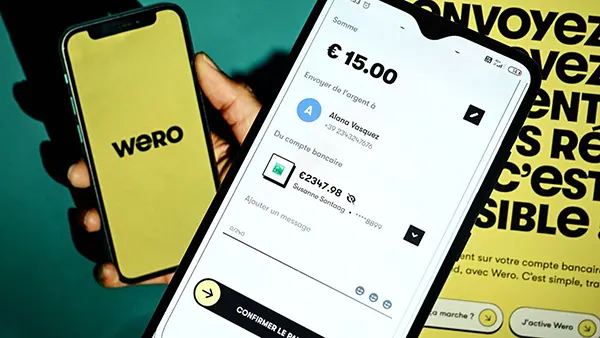
Wero – the Unified Digital Wallet for the European Union
In 2024–2025, Western Europe witnessed the rollout of Wero – an initiative driven by the European Payments Initiative (EPI) to establish a unified digital wallet across EU member states. This system aims to simplify domestic and cross-border payments by offering a secure, fast, and integrated mobile solution. As the EU steadily advances its digital sovereignty, Wero could mark a turning point in how European citizens pay, send, and manage money.
How Wero Works and Its Core Objectives
Wero functions as a mobile-first payment wallet developed through collaboration among major European banks and fintech institutions. It allows users to send and receive real-time payments using a phone number or email address and integrates with local bank accounts via SEPA instant credit transfers. The wallet is backed by rigorous security standards and aligns with PSD2 compliance.
One of Wero’s core goals is to reduce Europe’s dependency on non-European payment providers. This is achieved through interoperability across borders and domestic networks, ensuring user data stays within the EU and is handled according to GDPR principles. Additionally, Wero is designed to support peer-to-peer payments, online purchases, and in-store QR code transactions.
The adoption of Wero is also a political move toward financial independence. By introducing a homegrown digital payment solution, the EU intends to control key financial infrastructures and provide European alternatives to Visa, Mastercard, and Big Tech solutions like Apple Pay and Google Pay.
Benefits for Everyday Users and Merchants
For consumers, Wero delivers convenience by consolidating various payment needs into one application. It provides a seamless way to split bills, transfer money instantly, and pay online without needing physical cards. Moreover, biometric authentication and tokenisation ensure a secure user experience.
Merchants benefit from lower transaction fees and faster settlement times. With local bank integration and real-time capabilities, Wero shortens cash flow cycles and enables better liquidity. In addition, businesses can leverage Wero’s loyalty tools to offer digital receipts, promotions, and membership cards.
Integration with existing payment terminals is another advantage. Thanks to compatibility with standard QR and NFC systems, retailers do not need major hardware upgrades to accept Wero, making adoption cost-efficient and straightforward.
Wero in Gambling and eCommerce Integration
One of Wero’s most notable use cases is in the online gambling sector, where instant payouts and rapid deposits are critical. With real-time transactions, players can deposit funds and withdraw winnings in seconds. This eliminates the frustration of delayed transfers and increases trust between customers and gaming operators.
eCommerce platforms are also exploring Wero’s potential. Through open banking APIs, merchants can integrate Wero directly into checkout flows, giving users a frictionless payment method without redirecting to external gateways. This reduces cart abandonment and improves overall UX.
Moreover, the ability to authenticate payments via facial recognition or fingerprint allows for smooth and secure purchases. Coupled with two-factor authentication, Wero ensures high-level fraud protection, which is essential for gambling platforms and digital retailers handling sensitive financial data.
Loyalty, Customer Identity, and BNPL Innovations
Wero goes beyond payments by incorporating digital identity features. It supports eIDAS-compatible digital IDs, allowing users to verify age and identity when required by gambling or financial regulations. This makes onboarding faster and more compliant with KYC norms.
In future updates, Wero plans to include buy-now-pay-later (BNPL) functionality. Users will be able to access short-term credit lines during online purchases or even within gambling environments, where deposits can be made responsibly under controlled credit frameworks.
Furthermore, loyalty features embedded in Wero will enable service providers to create personalised offers. From cashback rewards to exclusive gaming bonuses, the system empowers businesses to build stronger customer relationships while respecting privacy standards.

Security Standards, Regulation and Long-Term Vision
Wero complies fully with EU-level financial regulations, including PSD2, GDPR, and the upcoming Digital Operational Resilience Act (DORA). It implements biometric login, end-to-end encryption, and tokenised transactions, ensuring user and merchant safety alike.
Cross-border compliance is a key element. Since Wero operates under the European Payments Initiative umbrella, its framework is recognised by regulators across the EU. This guarantees interoperability without risking fragmentation in local markets.
Looking ahead, the developers of Wero are working closely with the European Central Bank to ensure future integration with the Digital Euro, should it be launched. This positions Wero as not just a wallet, but an infrastructure component of the EU’s digital finance strategy for the next decade.
Challenges and Opportunities Ahead
Despite its promising framework, Wero faces stiff competition from well-established players such as PayPal, Revolut, and Apple Pay. Its success depends on mass adoption, strong bank partnerships, and persistent user education.
There are also technical hurdles, such as integrating with outdated banking systems in some member states and ensuring that all merchants adopt compatible acceptance infrastructure. A coordinated push is required to reach pan-European coverage.
However, with support from national banks and growing consumer demand for digital sovereignty, Wero is well-positioned to transform everyday payments. Whether in eCommerce, gaming, or public services, it presents a viable, European-first alternative with long-term potential.
